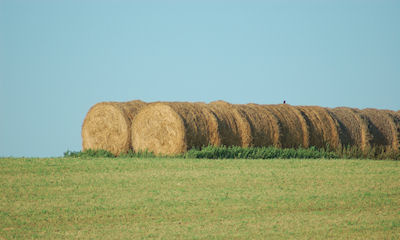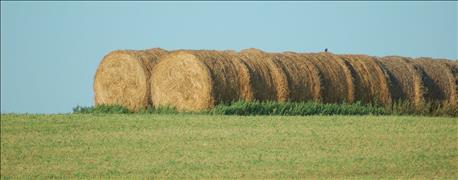May 10, 2016

Back in ‘the day’ I cut teeth on an Allis Chalmers Roto Baler. I never really asked why we had a round baler when no one else in the community did. I simply knew that when it was time to make hay, I was there.

Hay that has been stored outside could easily result in a loss of $20 per ton.
Grandpa, dad and my uncle had created a pull type, ground driven bale elevator that conveyed the bales the Roto Baler had dropped on the ground onto hay wagons for transport to the barn. The first job my cousin and I learned as boys was how to drive the bale elevator in a fashion that got the bales onto the wagons efficiently and without needing to jump off the tractor and straighten up a bale for the elevator. After all, these bales weighed 50 pounds each, and beginning at about age 8, we were happy to earn a nickel an hour driving the tractor instead of wrestling those 50 pound ‘rolling pins’ across the wagon or the hay mow. I often wonder today if it wasn’t Allis Chalmers decision in 1960 to discontinue manufacturing the Roto Baler that became the precursor for soon after seeing weight rooms being established in high school athletic facilities. But, that’s a conversation for another time.
Regardless, the real point I’m trying to make is that these round bales were picked up from the field as soon as possible after being baled, and then transported to barns for storage until they were fed. I wonder what they knew back then that we don’t know now.
As the AC Roto Baler became less popular, it was quickly replaced by larger round balers, and the need for storing hay inside seemingly disappeared. Today, large round bales of hay appear across many rural landscapes, unfortunately deteriorating a little bit more each day that they are housed outside.
In fact when hay bales sit unprotected and weather an average of 2 to 4 inches deep into the bale, the Extension publication “Round Bale Hay Storage in Kentucky” suggests 20% of the bale volume might easily be lost. When hay is valued at only $100/ton it quickly becomes a loss of $20 for each ton that’s stored unprotected. If we could build a ton’s worth of sheltered hay storage capacity for $200 or less, the annual cost of the structure amortized over 12 years would be less than the $20 per ton in value losses that easily result from outdoor hay storage.
It goes without saying all economic aspects of the beef cattle industry have changed dramatically in recent years. When hay was valued at only $30 to $40 a ton and it was abundantly available most anywhere, some might have argued they simply couldn’t afford to dedicate a building to hay storage. A quick look at the numbers today suggests it may be false economics to even consider utilizing hay as a basis for a beef cattle operation without the benefit of sheltered storage or some other protection such as wraps. The current value of hay and other feedstuffs dictates we may have simply returned to a place that Grandpa likely knew we should have never left. That is simply, “crops” were meant to be stored under roof!
While we’re visiting the issue of getting as many of the hay nutrients we harvest as possible preserved until we can feed them, it also may be time to evaluate how they’re fed. While we may lose 20% of our hay crop to poor storage management, additional losses of 12% or greater may be experienced as a result of poor bale ring management. Even worse, researchers suggest that unrolling round bales on the ground for feeding may result in as much as 40% loss. These feeding losses result from trampling, further weathering, manure contamination, and refusal resulting from mud or other issues that deter the animal from consuming the hay.
Frankly, I don’t recall ever seeing a steel “bale ring” highlighting the landscape as a youngster. I recall most everyone feeding hay in a bunk. Maybe they knew something back then that we’ve forgotten.
While large round bales, even those stored in a barn, are not conducive to being fed in bunks, once they are processed or chopped they certainly would be. OSU’s Dr. Francis Fluharty has published information that suggests processed hay is 30% more digestible than long stem hay fed as it comes directly from a typical large round bale. As we look for ways to save on the 12% feeding losses we typically experience in bale rings, perhaps we might consider processing forages to gain an additional 30% utilization.
As we examine the reality that all feed resources have become much more valuable, the traditional methods – if methods which we’ve established over only the past 40+ years can be considered “traditional” – of handling, storing and feeding hay may be obsolete. Not only is hay a commodity that should be stored inside, but the manure which results from feeding it is not a waste product but rather a commodity that provides valuable crop nutrients when managed correctly. But then, if I remember correctly, manure was our primary source of crop nutrients “back in the day” too. Perhaps, little has actually changed!
Stan Smith is the Program Assistant for Ag and Natural Resource in the Fairfield County office of Ohio State University Extension, and a member of the OSU Extension Beef Team. The Beef Team publishes the weekly Ohio BEEF Cattle letter which can be received via email or found at their website http://beef.osu.edu .
You May Also Like




